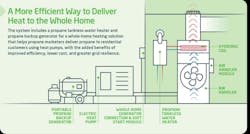Heat Smarter: How to Solve Winter Comfort Complaints
At the 2025 International Builders’ Show, heating performance was a hot topic. Builders shared that many homeowners weren’t happy with how electric heat pumps performed last winter. Homes took too long to warm up, and when the system relied on electric resistance backup, it led to higher bills and dry, uncomfortable air.
Successful builders know homeowners expect more than beautiful design; they want efficiency, sustainability, and affordability, too. Heating and cooling account for nearly a third of a home’s utility bill, so performance matters. Fortunately, advances in hybrid systems are giving builders new ways to deliver on those expectations.
The Pros and Cons of Electric Heat Pumps
Electric heat pumps are efficient because they transfer heat instead of generating it, but they struggle in cold weather. As outdoor temperatures drop, they become less effective at extracting heat from the air.
To keep up, the system switches to an electric resistance backup system, which can use three to four times more electricity. That spike not only drives up utility bills but it also strains the grid and leaves homeowners with a drier, less comfortable heat, often described as "harsh."
Where Hybrid Systems Come In
Hybrid, or dual-fuel systems can offer a solution, suplementing a home's existing heat pump when that system has reached capacity. Using electricity and an additional energy source, like propane, the system is a more cost-effective and reliable solution to maintain comfort during extreme cold.
A great example is the Heat Pump Helper. It works with a propane water heater, tankless unit, or boiler to support the home’s heating system, tackling two jobs at once. Hot water from a propane tankless water heater is circulated through coils in the air handler to warm air before it’s distributed through the ductwork. This reduces the need for electric backup, minimizes equipment wear, and keeps the system highly efficient. In some cases, propane-powered auxiliary heat with an air-source heat pump can reduce operating costs by up to 35%, while also providing hot water on demand.
At IBS, builders were also excited about pairing air-to-water heat pumps with boilers, expanding hydronic furnace lines, and new indirect water heaters from brands like Navien—giving them more tools to design for performance, comfort, and cost control.
Why Propane is Part of the Long-Term Solution
Another theme at IBS: limited access to natural gas infrastructre in new developments. It’s estimated that 58% of new single-family homes in 2025–26 will be built in areas where natural gas main extensions may be unavailable or delayed.
That reality is pushing builders to find alternative energy solutions, especially in remote or eco-sensitive locations.
While propane is often seen as a backup energy source, it's already used the primary heat solution in 5.8 million U.S. homes. The sytems are installed on site, and suppliers can work with builders to plan and size them for unique needs.
One real-world example: A coastal development near Myrtle Beach ran into a gas line capacity issue that could’ve halted construction. Instead, builders pivoted to propane, keeping the project moving forward. As a clean energy source that doesn't contaminate soil or groundwater, it was a good solution for the area's eco-sensitive needs. Today, that neighborhood features luxury homes powered by propane and equipped with high-efficiency tankless water heaters, proving that new homes don't need a pre-existing pipeline to be built.
Builders at IBS also noted they expect fewer restrictions on gas appliances in new construction going forward, which opens the door for more propane applications. Not only is it a potential substitute for natural gas and electricity, it's a forward-looking option with the flexibility to adapt to a range of system designs and site conditions. It can offer builders a way to meet performance goals and maintain construction timelines, even when utilities can’t keep up.
About the Author
Bryan Cordill, PERC
Bryan Cordill is the director of residential business development at the Propane Education & Research Council. He can be reached at [email protected]


